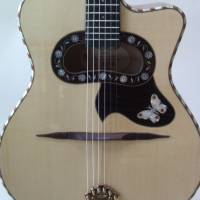DjangoBooks.com
Welcome to our Community!
Categories
- 20K All Categories
- 1.1K General
- 476 Welcome
- 59 Archtop Eddy's Corner
- 146 CD, DVD, and Concert Reviews
- 384 FAQ
- 26 Gypsy Jazz Italia
- 26 Photos
- 202 Gypsy Picking
- 21 Unaccompanied Django
- 15 Pearl Django Play-Along Vol.1
- 17 Gypsy Fire
- 45 Gypsy Rhythm
- 1.4K Gypsy Jazz University - Get Educated
- 130 Gypsy Jazz 101
- 224 Repertoire
- 218 History
- 707 Technique
- 51 Licks and Patterns
- 6 Daniel Givone Manouche Guitare Method Users Group
- 20 Eddie Lang Club
- 1.3K Gypsy Jazz Gear
- 801 Guitars, Strings, Picks, Amps, Pickups and Other Accessories
- 457 Classifieds
- 49 Recording
- 62 Other Instruments
- 18 Violin
- 5 Mandolin
- 22 Accordion
- 7 Bass
- 10 Woodwinds
- 347 Gypsy Jazz Events
- 143 North America
- 109 Europe
- 95 International
In this Discussion
Same scale, same action - why is one guitar easier to play..
 constantine
New York✭✭✭✭ Geronimo Mateos
constantine
New York✭✭✭✭ Geronimo Mateos













Comments
I reckon several other factors are not about a guitar being inherently smoother or easier to play, it's about familiarity with what you have become accustomed to. So much of technique is repetition and muscle memory.
This exact change happened on my guitar by only replacing the bridge. The old bridge was a regular rosewood and the new one is adjustable with thumbwheels albeit hand made specifically for a GJ guitar. I expected some sort of change in sound but didn't expect this change in the feel.
The guitar feels stiffer to play now, same action. This I have no idea how to explain except that the posts and thumbwheels added a hardness element that transferred to the overall feel.
I think what you did was that you replaced light bridge with a heavy one and that changes how responsive the guitar is. I would guess that now you have to pick louder to get the same sound out of it, right?
Actually it was sort of the other way around. With the new adjustable bridge, the guitar completely changed it's voice and you could say it opened up. I'm going to do a thread about it. It's a little bit heavier, weighs in at about 14-15 grams and I believe the old all solid wood was about 12, but I'll have to double-check that.
With the old bridge, and any other bridge I tried, the guitar was kinda Selmer-ish in it's voice. Now it's all Favino. Tons of mids, lost some bassiness but the bass tightened up considerably. I feel it projects a lot more. I'm going to test that tonight hopefully, at the local jam. I'm going to ask some people to try to listen and tell me if they noticed a difference without telling why. Although the thumbwheels are a dead giveaway.
This bridge is made specifically for a GJ guitar, by a friend luthier who plays this kind of music. His experience is the same on the other guitars he fitted with this type of bridge, it opened up the sound.
It's about 15 grams like mentioned but there's space to get it lighter.
And it takes less effort to pick.
But this change in feel and stiffness, I'm at a loss with that. I'm going to go back and forth between the two, maybe it's the change in tone that makes me think it feels different. But past few days I've played it, I keep feeling like my fingers need to press down harder.
Now, what I think you might refer to regarding needing to dig in with some of these guitars is when they're made with very dry sound in mind. At least that was my experience, the drier the sound, the guitar would give less to me as a player but would project very well. To the audience it would be very loud.
I as a player still prefer to get some back from the guitar even at a cost of some loss of projection. Although with some exceptional guitars you get the best of both worlds.
One more thing, he mentioned it indirectly, is the neck angle. The steeper the angle the more tension is created. Strings can play a role too, D'addarios always felt very stiff to me versus say some of the silk and steel which are usually very supple.
So many variables...
Not trying to be too metaphysical about it (I'm an engineer by profession) but 'feel' does come into play especially in a hand built instrument. Funny thing, like with the neck shape, it is hand shaped but should LOOK like it was made by a machine (finish, symmetry, etc).
Hey Buco, not to disagree too much but neck angle (and angle over the bridge really just changes the downward force on the top, the tension is pretty much just scale length and string gauge (assuming all other factors equal).